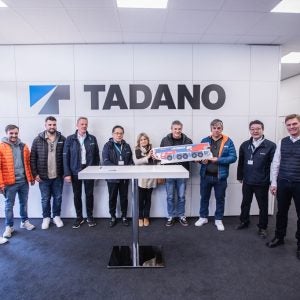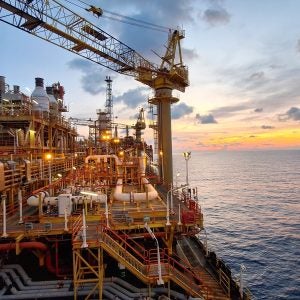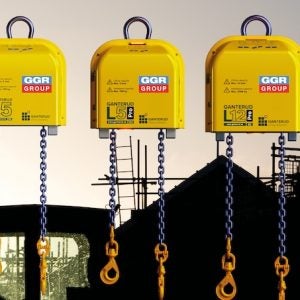Terex Corporation reported second quarter net income before non-recurring items of $14.2m on net sales of $439.3m. Strong performers in the lifting business were tower cranes, lattice boom crawlers, US-built small hydraulic mobile cranes and boom trucks. Most other Terex crane products declined during the period.
“We remain encouraged with Terex’s performance during the first half of 2001 in the midst of a very challenging environment,” said Ron DeFeo, Terex chairman and chief executive officer. “Despite volume declines in the 20% to 25% range in several of our product lines, we remain solidly profitable. We expect to take advantage of an eventual economic recovery, in large part due to the leverage created by our favourable cost structure.” Net sales for the second quarter were down 23% to $439.3m, compared to $569.3m during the second quarter of 2000 (excluding last year’s second quarter sales of $24.2m from the truck-mounted forklift operations that were divested at the end of the third quarter of 2000). Operating profit was down 29% to $42.4m in the second quarter (excluding the impact of the non-recurring item), compared to $59.4m in the second quarter of last year (excluding last year’s second quarter operating profit of $4.1m from divested operations), primarily due to the impact of the across-the-board volume decline in most of Terex businesses in both North America and Europe.
Net sales for the first six months of 2001 were down 20% to $916.7m, compared to last year’s first half sales of $1,147.0m. Operating profit in the first half of 2001 was down 28% to $80.4m (excluding the impact of the non-recurring item in the second quarter) compared to $111.5m in the first half of 2000 (excluding last year’s first half operating profit of $7.0m from the divested operations). Despite sales declines of approximately 20%, operating margins declined only to 8.4%, compared to 10.3% in 2000. First half operating expenses declined from $84.8m in 2000 to $81.6m this year.
Terex’s group order book stood at $190.8m on 30 June 2001, compared with $313.5m 12 months previously.
In April Terex announced a new operating structure, under which it is no longer divided into product segments but – broadly – into two geographic regions. The two divisions now are the Americas and Mining Group (A&M) and Terex Europe.
Net sales in A&M were down 34% to $266.2m during the second quarter compared to $401.8m in the second quarter of 2000. Operating profit was $20.1m in the quarter. Double-digit revenue decline was experienced in the lifting business as well as in the mining, paving and hot-mix asphalt plant and construction truck businesses. The mining business was also negatively affected by a $11.8m revenue reversal as a result of a mining customer returning five trucks that only delivered 97% of the committed performance in a very unusual high altitude working environment in Chile. Lattice boom cranes, small hydraulic mobile cranes and boom trucks businesses were among strong performers in the quarter, the company said.
“Despite a difficult market environment in several of our industries, we were able to deliver profitable performance and maintain strong operating margins,” said Ernie Verebelyi, group president of Terex Americas & Mining. “We continued during the quarter to increase our market penetration in both hydraulic mobile cranes and boom trucks. We are in the process of integrating our sales and marketing functions across businesses in the Americas in order to leverage our value proposition with major customers. We are also in the process of consolidating some of our manufacturing facilities to further reduce the cost structure within our group.” Net sales of Terex Europe fell 8% in the quarter to $231m, compared with last year’s $252m (from continuing businesses). Operating profit fell 26% to $23.2m.
Over the first half of the year net sales were down 11% to $ 454.9m and operating profit down 26% to $39.2m.
The European segment was negatively affected by a double-digit decline in the lifting business, Terex said, although the tower crane business continues to grow in Europe and North America.
“We expect the second half of this year to remain a challenging one, requiring outstanding execution to achieve our objectives,” said Ron DeFeo. “The business environment, which started to deteriorate during the second half of last year, remains difficult and is expected to remain that way for the rest of 2001. We expect continuing soft activity in both the North American and European construction markets for the balance of 2001.” Mr. DeFeo added, “We have several actions underway designed to improve our competitive position in these challenging markets. Earlier in the second quarter we announced a new organisational structure that should allow us to be more responsive to our customers and reduce duplicative cost structures that were created as a result of the many acquisitions we made over the past several years. Late in the second quarter, on the heels of the changes in the organisational structure, we announced our intent to close four manufacturing facilities, two in Europe and two in North America. This restructuring, which will require a one-time charge of $15m to $20m before year-end, will allow us to reduce costs by approximately $10m to $15m on an annual basis and will provide us with the opportunity to improve the manufacturing, capacity utilisation, and cost efficiency of some of our remaining facilities. I also know that we have more work to do.”






